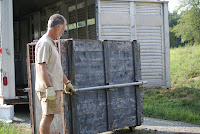 Fenimore shortly after his arrival to CPT quarantine, with the face of a worn teddy bear
Fenimore shortly after his arrival to CPT quarantine, with the face of a worn teddy bearCPT received 4 tigers from the Wesa-a-geh-ya facility in Missouri when the facility closed following a tiger attack on a volunteer. The 26-year-old volunteer, Jacob Barr, underwent surgery and lost his leg below the knee. The tiger, Hercules, was shot.
How many animals were there? Where did they go?
G.W. Exotic Animal Memorial Park in Oklahoma picked up 8 lions, 4 tigers, a cougar, a leopard, and 6 other exotic animals from Wesa. Our four tigers were the next to leave on September 4th, and the remaining 15 tigers will be going to Serenity Springs in Colorado.
What sort of situation were the animals in?
There is a significant amount of ongoing debate about animal care at Wesa-a-Geh-Ya and about its responsibility in the attack. If you would like to know more about the controversial history of the facility, the community discussion on Topix.com's Warrenton Forum seems to be the hub of the debate and a good place to start.
How did the tigers get to CPT? How does that work?
After the story hit the news, Curator Kathryn Bertok contacted Sandra Smith at Wesa and the Warrenton sheriff to let them know we were in a position to take 4 animals. We received a call back from Joe Schreibvogel, of G.W. Exotics, who was assisting Sandra in placing the animals. CPT was given a list of 23 tigers, with sexes and approximate ages. We agreed to take 4 tigers pending a donation agreement. The donation agreement is an official transfer of ownership and a statement that Ms.Smith would not attempt to own dangerous exotic animals in the future.
This is a hard stance, but an important one. The surplus of tigers bred in captivity for the pet and entertainment trades is such a large problem in the US, that it is regular practice for breeders to place their animals out, only to start over again. The donation agreement is intended to prevent this type of abuse of the sanctuary system.
There was a delay of about a week while waiting for the return of the agreement. During this time, Kathryn planned for the tiger's transport. Scott, our former-skydiving Volunteer Coordinator, jokingly suggested parachuting them in. Tigers are shipped in heavy-duty crates, but whose crates and how to get them to Missouri posed a big hurdle.The local sheriff had set a deadline for the animals to be off Wesa property by September 16th.
CPT received the donation agreement, and then everything was GO! Prior to their arrival, we didn't even know the names of the tigers that would be coming! Kathryn constantly relayed updates (and lack thereof) as the tigers were picked up: that they walked right into their transport crates, they were stuck in traffic and one of the males wasn't happy about it (when you get to know them, you'll guess which one that was).
How did the tigers get to CPT? How does that work?
After the story hit the news, Curator Kathryn Bertok contacted Sandra Smith at Wesa and the Warrenton sheriff to let them know we were in a position to take 4 animals. We received a call back from Joe Schreibvogel, of G.W. Exotics, who was assisting Sandra in placing the animals. CPT was given a list of 23 tigers, with sexes and approximate ages. We agreed to take 4 tigers pending a donation agreement. The donation agreement is an official transfer of ownership and a statement that Ms.Smith would not attempt to own dangerous exotic animals in the future.
This is a hard stance, but an important one. The surplus of tigers bred in captivity for the pet and entertainment trades is such a large problem in the US, that it is regular practice for breeders to place their animals out, only to start over again. The donation agreement is intended to prevent this type of abuse of the sanctuary system.
There was a delay of about a week while waiting for the return of the agreement. During this time, Kathryn planned for the tiger's transport. Scott, our former-skydiving Volunteer Coordinator, jokingly suggested parachuting them in. Tigers are shipped in heavy-duty crates, but whose crates and how to get them to Missouri posed a big hurdle.The local sheriff had set a deadline for the animals to be off Wesa property by September 16th.
CPT received the donation agreement, and then everything was GO! Prior to their arrival, we didn't even know the names of the tigers that would be coming! Kathryn constantly relayed updates (and lack thereof) as the tigers were picked up: that they walked right into their transport crates, they were stuck in traffic and one of the males wasn't happy about it (when you get to know them, you'll guess which one that was).
The morning of the arrival, I got to work at 7:30. As I pulled in, Keepers Mary and Lauren started yelling and pointing, and walking down to the visitor lot, as I tried to get video and photography gear together. The tigers had arrived in a large, air-conditioned cattle trailer.
The tigers in the compound can tell when something is up- morning rounds were early that day, and the cats don't very often see short caravans of vehicles coming through. Rajah wanted to know what was going on.
When Curt opened the doors to the trailer, Emerson (aka Labyrinth) had some pretty nasty things to say. Kathryn took a few minutes to talk to him.

The first tiger unloaded was Fenimore. He seemed nervous about Emerson's loud complaints. The crate surprised me- I had not expected something so open; it reminded me of the drawings on a box of animal crackers. Circus tigers may spend 11 months of their year riding around in boxes like this! I'm glad Fenimore only had to be there for 24 hours.
To make sure the tiger does not escape during the transfer, the crate is strapped flush to the quarantine gate. Fenimore entered quarantine quickly.

Emerson was the second tiger unloaded. The process was similar, only with a lot more tension. Transporting tigers is a stressful process, and there's only so much that can be done to make it easier. CPT staff know now that Emerson is distrustful of men. You can tell from his body language here, he's not a happy camper. He also entered quarantine quickly.
Then it was time for the girls! Mona's crate proved difficult to roll, and staff decided she would be lifted into place. Blankets were placed on one side of the crate so the tractor would not startle her- and she seemed to handle things well!
But once in place, Mona took a peek into the quarantine bay, with Emerson snarling in the background, and decided she was just fine where she was. It was a bit dark and scary in there! After unsuccessful tries to coax her in, Transporter Curt decided to clean her off a bit.
 Left: Moki's crate
Left: Moki's crate
With Mona dallying at the front gate, staff decided to set up Moki to enter the back. Moki's crate was narrower than the others, and more enclosed. The wooden sides of the crate had Arabic writing. When I asked Curt about this, he said the crate had been used to ship a lion out of the Kuwait zoo. It made me wonder the stories each crate could tell.
There wasn't much to see as they unloaded Moki. You couldn't really see inside the crate, and though she entered fairly quickly, I stayed outside so as not to upset Emerson.
Mona eventually entered of her own accord, and we adjourned to the house to give them time to settle in.
Mona eventually entered of her own accord, and we adjourned to the house to give them time to settle in.
I've put more recent photos up on CPT Facebook
Watch for posts showing the Wesa tigers' vet exams and release to their outdoor enclosures.





